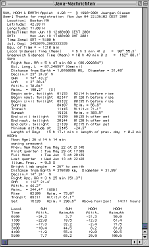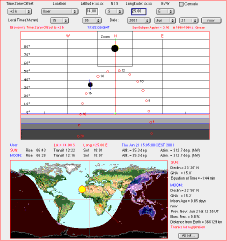(currently
26 applets and growing) is available for $20.
A
recurring theme in Giesen's work is the motions of the Sun
and Moon. Among his computations are their paths relative to
the local horizon, sunrise/sunset times, lunar phases, and
the analemma. He frequently turns to the works of Jean
Meeus, particularly Astronomical Algorithms, and Oliver
Montenbruck and Thomas Pfleger's Astronomy on the Personal
Computer as sources of formulas for his astronomical
computing projects.
An
Applet Sampler
The
Sun, Moon and Earth applet is a prime example of the
level of interactivity that Java can bring to a Web page.
The program's window is divided into two panels: the upper
shows a Mercator view of the observer's horizon, while the
lower presents the illuminated hemisphere of the Earth on a
world- map for the date and time specified.
The
user can choose his or her desired location in three ways:
entering the geographical coordinates of the site, clicking
on the world map, or selecting a nearby city from the pop-up
gazetteer on the control panel at the top of the window.
Here the user can also enter any desired date, time, and
time zone from pop-up menus. Every piece of screen estate
displays information on the rise/set/transit times for the
Sun and Moon, their declinations, Greenwich hour angles,
and


Left: The local solar and lunar viewing circumstances are revealed in Juergen Giesen's "Sun, Moon and Earth" applet. Right: Not all of the applet's computational output is revealed by the graphical display _ users can write a comprehensive topocentric ephemeris to the Java console for printing out.
physical appearance. All these data and more can be written to the Java console _ a very useful feature I'd like to see implemented on commercial astronomical software packages.
If one were to photograph the Sun at local noon every day for a year, its path against the sky would be a drawn-out figure eight, owing to the changing solar declination and the equation of time. Giesen's Analemma
a
Mercator view of the local horizon with the positions of the
Sun and Moon depicted for various times throughout their
periods of visibility. The lower portion of the window shows
the world map with the subsolar point and pertinent
observational data for the Sun and Moon. Can't take your
computer with you? Then use the Java console to print out a
precise topocentric ephemeris to bring along.
Everyone
will find a use for Moon Phase. The applet's name says it
all _ it computes the date and Universal Time of
the four principal phases of the Moon throughout the
year.
Giesen
also takes an interest in astrophysics and cosmological
models. So, if you feel like controlling the fate of the
universe, try his Cosmology applet. You can experiment with
the initial state of the Big Bang and modify parameters to
see if the universe expands indefinitely or collapses into a
Big Crunch.
Giesen
points out that his astronomical interests are not limited
to his "hobby programming," as he calls it. He owns a 4-inch
Newtonian reflector with which he keeps a close eye on the
Moon and bright planets. He also keeps a record of sunspot
activity and tries his hand at astrophotography _
such as capturing the solar eclipse of August 11,
1999.
ADRIAN
ASHFORD is Sky & Telescope's newest associate
editor.
 Eclipse chasers preparing for Africa this month may want to give the "Solar Eclipse" applet a run. A full topocentric ephemeris con be printed from the Java console. |
applies
that information to the plotting of a shadow from a
gnomon of user defined height. The control panel at
the top of the Java window shares much of the
functionality of the former example, where the
desired location, date, time, and time zone can be
selected from pop-up menus. This is a must for the
aspiring garden sundial builder. |
Sky & Telescope | June 2001 59